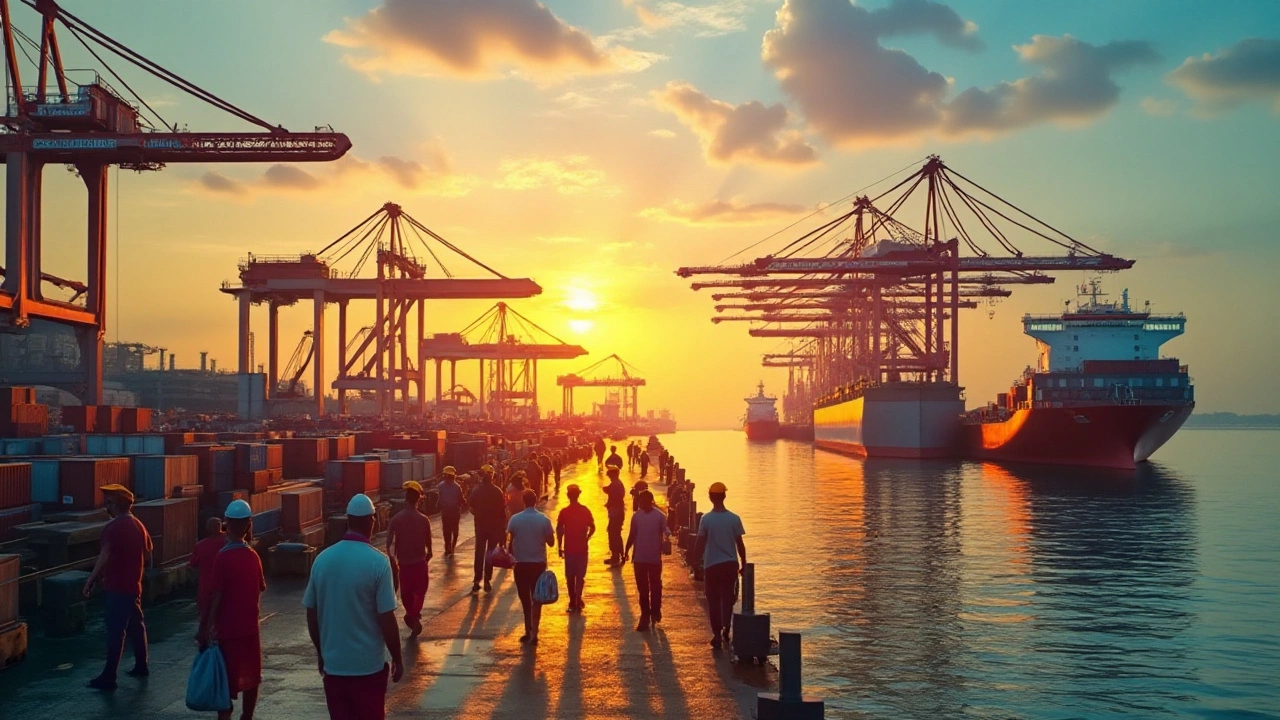When it comes to international shipping, selecting the right method can make all the difference. Businesses have a couple of primary options: sea freight and air freight. Each method brings its own sets of benefits and challenges.
In this article, we'll navigate through these options, offering practical insights to help you make the best choice for your needs. By comparing aspects such as cost efficiency, speed, and sustainability, you'll discover the nuances that define each shipping method.
Whether you're managing a small enterprise or a large corporation, understanding these key factors will streamline your shipping processes and enhance your global reach.
- Understanding Shipping Methods
- Factors Affecting Cost
- Speed and Reliability: A Comparison
- Environmental Considerations
Understanding Shipping Methods
In the realm of international shipping, two titans stand out: sea freight and air freight. Each has carved out its niche in the logistics world, catering to varying consumer needs and business demands across the globe. Recognizing the fundamental differences between these two can help make informed decisions tailored to a specific business model. Essentially, sea freight has a storied history, serving as the backbone of global trade for centuries. It involves transporting goods in large shipping containers on cargo ships that sail from port to port. With immense capacity, sea freight is particularly suitable for bulk shipments and items that aren't perishable. It's the go-to option for those looking to optimize costs, especially over long distances.
On the other hand, air freight is known for its speed. Airplanes quickly transport goods across continents, catering to companies that prioritize quick turnaround times. Though it comes with a heftier price tag, the efficiency and speed make it attractive for high-value or time-sensitive goods. Imagine needing to ship luxury items or fresh produce—air freight ensures these reach their destination swiftly, minimizing risk of spoilage or depreciation in value. Yet, air freight isn't without its constraints. There's a limitation on the weight and volume an aircraft can carry, meaning not all shipments are suitable for this method.
To better grasp the capabilities and limitations of each method, it can be helpful to look at some numbers from 2023. Recent data shows that about 90% of the world’s goods are transported by sea, which highlights the sheer dominance of sea freight in the global logistics market.
"With the ever-growing demand for ecommerce, logistics strategies have become more crucial," said Jake Smith, logistics analyst at Global Trade Insights. "Choosing the right shipping method can significantly impact operational scalability and customer satisfaction."Each method offers unique advantages depending on the shipment's size, urgency, and nature. When deciding between the two, it's crucial to assess your priorities—whether that's reducing costs or speeding up delivery. Thus, gaining a thorough understanding of these shipping methods equips businesses with the knowledge to navigate the global trade waters effectively.

Factors Affecting Cost
Shipping goods across international borders involves multiple cost considerations, many of which are influenced by the selected method—sea freight or air freight. Understanding these factors is crucial for businesses aiming to manage expenses effectively. The weight and volume of the shipment play a significant role. Sea freight, known for handling large volumes, might not charge based on weight but rather on container size. Therefore, larger shipments that are heavy and bulky are most often more cost-efficient when traveling by sea. In contrast, air freight charges tend to be based on both weight and size, making it ideal for lighter, compact shipments that require rapid delivery.
Another critical element is the distance between the origin and destination points. Sea routes, although often longer, are more predictable and relatively less expensive over vast distances. Airlines, meanwhile, can cover great distances quickly, but at a premium. Businesses should also consider the regularity and flexibility of schedules when choosing a method, as delays may lead to additional holding or storage costs, affecting the final bill.
Handling fees and customs duties also contribute significantly to international shipping costs. Sea freight can incur higher handling fees due to the larger workforce required to load and unload containers. While air freight requires less manual intervention, the security and procedural expenses can escalate quickly, especially if shipping to regions with stringent regulations. Import tariffs, insurance, and currency fluctuations are also worth factoring into the cost equation. Shipping by sea might offer slightly lower insurance premiums, given the longer yet generally safer transit route, while air freight insurances could be higher due to perceived risks.
Additional charges such as packaging, warehousing, and inland transport once the shipment reaches its destination must not be overlooked. Businesses need to opt for robust packaging, especially for sea freight, which faces harsher environmental conditions during its journey. This necessity often elevates expenses. Additionally, warehousing costs will differ greatly, with air freight typically spending less time in storage due to its speed, while sea freight could experience longer lead times, affecting storage budgets. Inland transport costs depend massively on the proximity of warehouses to major ports or airports, with different logistical challenges presented by each.
"Effective cost management in international shipping requires a holistic approach, accounting for all elements from transit mode to eventual delivery," notes Linda Thompson, a logistics expert from Global Trade Consultants.
A comprehensive comparison would not be complete without addressing hidden costs—often, charges related to customs documentation, taxes, and legalization of trade documents fall into this category. Many businesses have learned to factor a percentage of their budget to accommodate unforeseen expenses that may arise. The shipping industry's volatile nature and its external dependencies make calculating an exact freight cost challenging, emphasizing the importance of detailed planning and negotiation.
Economic shifts, geopolitical variables, and seasonal demand fluctuations also play a critical role. During peak seasons, costs can surge, requiring businesses to book well in advance to secure a fair rate. Sea freight often sees significant seasonal variation, with costs spiking around the holiday season, while air freight rates can be more stable but tend to rise rapidly with increased demand.

Speed and Reliability: A Comparison
Speed plays an unmistakably crucial role in the world of international shipping, especially when a business is focused on timeliness. Air freight is often celebrated for its rapid transportation capabilities, allowing shipments to cross continents in a matter of hours rather than weeks. This accelerated pace can significantly benefit businesses dealing with perishable goods or those that need to meet urgent customer demands. Many large corporations prioritize air freight when they launch new products globally, ensuring that audiences in every corner of the world gain simultaneous access.
On the other side of the coin, sea freight offers a more time-intensive journey due to the logistics involved. Although it typically takes longer to travel between ports, it is highly favored for its cost-effectiveness. However, speed is just one piece of the puzzle. Reliability is equally important, with air freight often boasting a better track record. The precision of flight schedules, despite occasional delays, means that air freight tends to stick to its timelines more consistently. In contrast, sea freight, while generally reliable, can be subject to uncontrollable delays due to adverse weather conditions or port congestion.
Reliability in shipping methods also factors in the potential for damage or loss. Air freight generally offers better handling, thus reducing the risks associated with damage, which can be pivotal for delicate or high-value goods. Sea freight, while robust, may require extra packaging to ensure goods are safe against the conditions they might face at sea. According to the International Chamber of Shipping, "Sea lanes account for over 90% of global trade, yet require high levels of coordination to avoid shipment delays." Such a statement emphasizes the importance of strategic planning when utilizing sea freight for timely delivery.
Breaking Down Reliability
Another layer to consider is the infrastructure supporting these shipping methods. Airports usually provide detailed tracking services, which allow businesses to monitor their cargo in real-time. This transparency is beneficial for companies that value an established timeline. Sea ports, with their vast scale and unique customs regulations, might take a longer time to process shipments, affecting predictability. Nevertheless, advancements in technology and logistics are constantly improving the reliability of sea freight services. A DHL report once pointed out that by leveraging predictive analytics, sea freight predictions are becoming increasingly precise, promising enhanced reliability over time.It's worth noting the environmental impact tracked alongside reliability and speed. Air freight, due to its high fuel consumption, leaves a larger carbon footprint in comparison to sea freight. Businesses that remain environmentally conscious might opt for sea transport, accepting longer delivery times in exchange for a greener profile. Such decisions are often part of larger corporate social responsibility strategies, reflecting an evolving business ethos geared towards sustainability. Ultimately, whether businesses choose air or sea, the alignment with shipping strategies hinges on understanding and weighing these critical factors.

Environmental Considerations
When we dive into the world of international shipping, one aspect that commands our attention is its environmental impact. The choices we make here can have far-reaching consequences on our planet. Sea freight and air freight, the two most prominent shipping methods, offer contrasting environmental footprints. Sea freight, traditionally, emerges as a more sustainable option. Ships may take longer to deliver goods, but they can carry substantial cargo with a comparatively lower carbon output. It's like comparing a spacious family van to a nimble but gas-guzzling sports car in terms of emissions efficiency.
On the other hand, air freight, despite its speed, presents challenges. Planes emit a significant amount of carbon dioxide and other pollutants. The high altitude of these emissions means they often have a more pronounced greenhouse effect on our climate. A plane can transport goods in hours, but the environmental cost of that speed is a hefty price tag for Mother Earth. Thus, while companies might enjoy the benefits of quick delivery, they may also need to weigh this against their sustainability commitments.
Carbon Emission Comparisons
If we peek into statistical data, the numbers often reveal a striking contrast. Shipping via sea can produce as little as 15 grams of CO2 per ton-kilometer, whereas air freight can go up to 500 grams for the same measure. These figures paint a vivid picture of why many firms are advocating for greener maritime shipping alternatives. Some reports suggest that if the shipping industry were a country, it would rank among the top global polluters. However, recent advancements, such as slow steaming and newer fuel technologies, are curbing emissions significantly.
Susan Sims, a climate analyst from a reputed research group, once stated, "While air freight may win the race for speed, sea freight secures the gold for sustainability across the globe."
Nevertheless, it's not just about CO2 emissions. Other factors, such as fuel consumption and noise pollution, must be considered. Marine engines primarily run on heavy fuel oil, known for its sulfur content, which affects marine ecosystems and coastal communities. Initiatives like the International Maritime Organization's regulations aim to reduce sulfur emissions, offering a hopeful trajectory for environmentally-conscious shipping.
Innovations Paving the Way
Exciting innovations continue to emerge. Electric and hybrid ships are edging closer to becoming mainstream, offering clean, efficient alternatives. Similarly, the aviation industry is researching sustainable aviation fuels to lessen its ecological footprint, although these innovations are currently more theoretical than practical. Companies integrating these technologies may find themselves favored by consumers who prioritize sustainability in their purchasing decisions.
Efforts by governments and international bodies are making waves, too. Incentives for companies adopting eco-friendly practices in shipping methods can provide a significant push towards change. Public perception also plays a pivotal role, as transparency in a company's environmental commitments can shape consumer loyalty. The road to sustainable shipping might seem arduous, but every step, no matter how small, brings us closer to a greener horizon.





